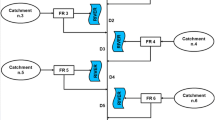Abstract
Already today, the functionality of many sewer and storm water systems are not up to the required standards and consequently flooding problems are experienced in case of heavy storms. System upgrades are required, which are however complicated by the expected future increase in short-term rainfall intensities as a result of climate change. In this case study, focusing on the town of Arvika, Sweden, this issue is investigated in three main steps. In the first, extreme value analyses of 30-min rainfall from an ensemble of climate projections are carried out to estimate the future increase and generate a future design storm. In the second, the existing system’s response to both today’s and future design storms are simulated by a coarse sewer model setup (MOUSE) and a detailed coupled surface-sewer model setup (TSR). In the third and final step, system upgrades are designed and evaluated by both models. The results indicate an increase by 10–30 % of today’s short-term rainfall extremes by the end of the century. Upgrading the system to achieve a satisfactory performance for the future design storm would cost approximately twice as much as an upgrade based on today’s design storm.












Similar content being viewed by others
References
Amaguchi H, Kawamura A, Olsson J, Takasaki T (2012) Development and testing of a distributed urban storm runoff event model with a vector-based catchment delineation. J Hydrol 420–421:205–215. doi: 10.1016/j.jhydrol.2011.12.003
Ando Y, Takahashi Y, Izumi K, Kanno K (1986) Urban flood modeling considering infiltration various land uses. In: Maksimović Č, Radojković M (eds) Urban drainage modelling. Pergamon Press, Oxford
Arnbjerg-Nielsen K (2006) Significant climate change of extreme rainfall in Denmark. Water Sci Technol 54:1–8
Bengtsson L, Milotti S (2008) Intensive storms in Malmö. Vatten 64:291–304 (in Swedish with English abstract)
De Toffol S, Laghari AN, Rauch W (2009) Are extreme rainfall intensities more frequent? Analysis of trends in rainfall patterns relevant to urban drainage systems. Water Sci Technol 59:1769–1776. doi:10.2166/wst.2009.182
Grum M, Jørgensen A, Johansen R, Linde J (2006) The effects of climate change on urban drainage: an evaluation based on regional climate model simulations. Water Sci Technol 54:9–15
Hanel M, Buishand TA (2010) On the value of hourly precipitation extremes in regional climate model simulations. J Hydrol 393:265–273. doi:10.1016/j.jhydrol.2010.08.024
Kjellström E, Bärring L, Gollvik S, Hansson U, Jones C, Samuelsson P, Rummukainen M, Ullerstig A, Willén U, Wyser K (2005) A 140-year simulation of European climate with the new version of the Rossby Centre regional atmospheric climate model (RCA3). Reports Meteorology and Climatology 108, SMHI, Sweden
Larsen AN, Gregersen IB, Christensen OB, Linde JJ, Mikkelsen PS (2009) Potential future increase in extreme one-hour precipitation events over Europe due to climate change. Water Sci Technol 60:2205–2216
Nakićenović N, Alcamo J, Davis G, de Vries B, Fenhann J, Gaffin S, Gregory K, Grübler A (2000) Special report on emissions scenarios, Working Group III, Intergovernmental Panel on Climate Change (IPCC). Cambridge University Press, Cambridge
Olsson J, Berggren K, Olofsson M, Viklander M (2009) Applying climate model precipitation scenarios for urban hydrological assessment: a case study in Kalmar City, Sweden. Atm Res 92:364–375
Olsson J, Willén U, Kawamura A (2011) Downscaling extreme Regional Climate Model (RCM) precipitation for urban hydrological applications. Hydrol Res in press
Onof C, Arnbjerg-Nielsen K (2009) Quantification of anticipated future changes in high resolution design rainfall for urban areas. Atm Res 92:350–363
Pagliara S, Viti C, Gozzini B, Meneguzzo F, Crisci A (1998) Uncertainties and trends in extreme rainfall series in Tuscany, Italy: effects on urban drainage network design. Water Sci Technol 37:195–202
Semadeni-Davies A, Hernebring C, Svensson G, Gustafsson L-G (2008) The impacts of climate change and urbanisation on drainage in Helsingborg, Sweden: Suburban stormwater. J Hydrol 350:114–125
Vatten S (2004) Publication P90—dimensioning of common sewers. Svenskt Vatten AB, Motala
Trenberth KE, Dai A, Rasmussen RM, Parsons DB (2003) The changing character of precipitation. Bull Am Meteorol Soc 84:1205–1217
Vaes G, Willems P, Berlamont J (2002) Hundred years of Belgian rainfall: are there trends? Water Sci Technol 45:55–61
Van de Ven FMH, Nelen AJM, Geldof GD (1992) Chapter 5. Urban drainage. In: Smart P, Herbertson JG (eds) Drainage design. Blackie, New York
Yen BC (1991) Hydraulic resistance in open channel. In: Yen BC (ed) Channel flow resistance: centennial of manning’s formula. Water Resources Publications, Colorado
Acknowledgements
The study was mainly performed within the project Climate Proof Areas (CPA), funded by EU through the Interreg IVB North Sea Region Programme. Funding was also provided by the Foundation for Strategic Environmental Research (MISTRA), through project Mistra-SWECIA, the Swedish Research Council Formas, through project Hydroimpacts 2.0, and by Tokyo Metropolitan University. We gratefully acknowledge this funding. We also thank Kean Foster for assistance with climate projection data and three reviewers for constructive and helpful comments on the original manuscript.
Author information
Authors and Affiliations
Corresponding author
Rights and permissions
About this article
Cite this article
Olsson, J., Amaguchi, H., Alsterhag, E. et al. Adaptation to climate change impacts on urban storm water: a case study in Arvika, Sweden. Climatic Change 116, 231–247 (2013). https://doi.org/10.1007/s10584-012-0480-y
Received:
Accepted:
Published:
Issue Date:
DOI: https://doi.org/10.1007/s10584-012-0480-y




